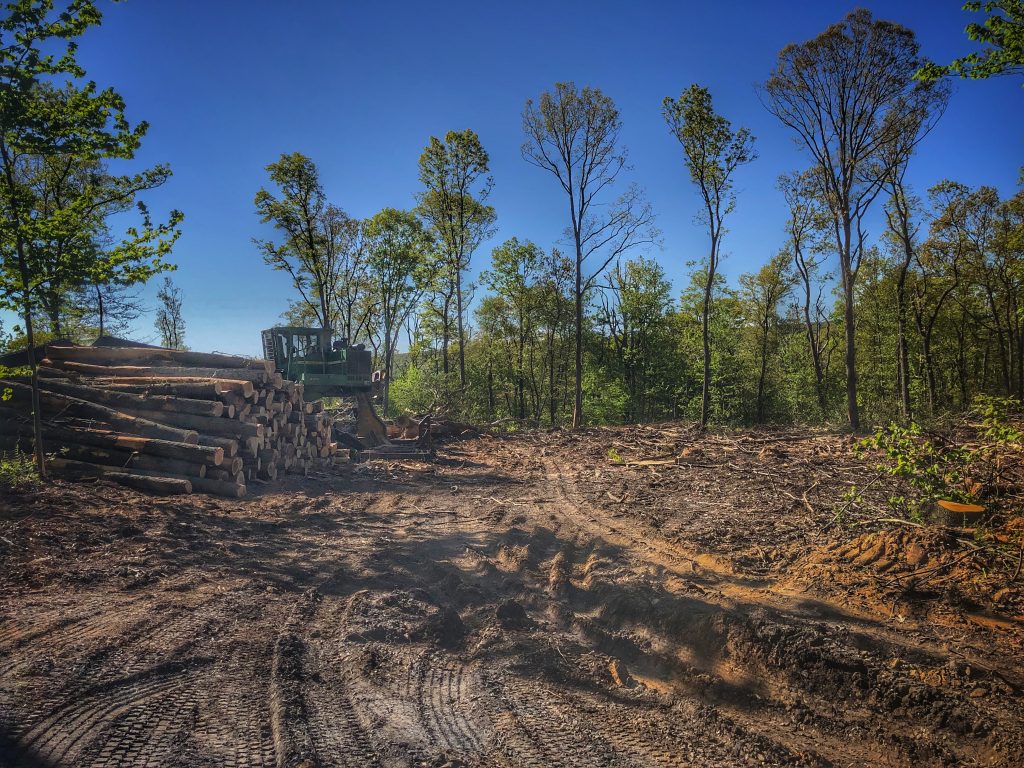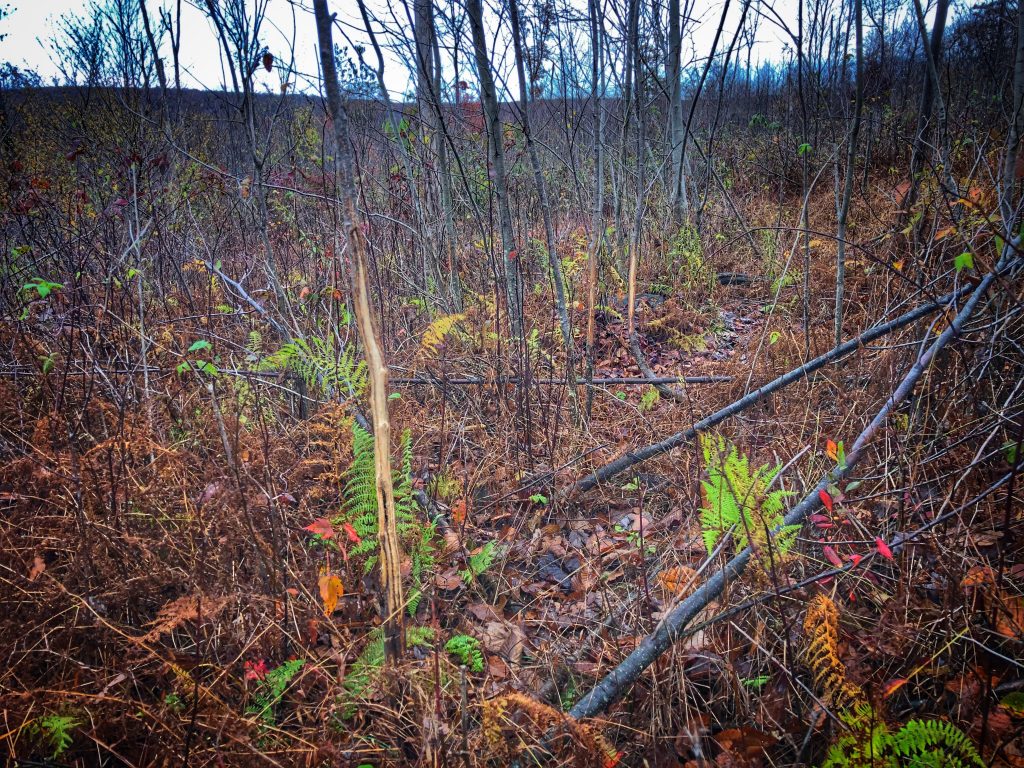Funnels, Terrain, and Pinch-points for Hunting Clear-cuts.
With temperatures 12-15 degrees cooler than what the thermometer had shown the previous few days, conditions on this mid-October morning were perfect, and I couldn’t be more excited to make my way into the deer woods. On our 3-mile hike, my hunting partner and I weren’t nearly as worn out and sweaty as we normally would have been—a collateral bonus granted by the chilled air. After we separated to make our way to our chosen trees, I picked my way with some effort through alanding area for felled logs. Next traveling down a long skiddertrail, I found myself in the midst of a 5-year-old clear-cut. Thecover was dense, but I had found that the skidder trail led to a few seed-producing trees. In the center of those trees, there was a pothole that consistently held water through dry periods of the year. I climbed a tree that I could barely get my arms around and settled in. Although I was relatively new to public land hunting, I knew this spot held promise. At the time I did not yet own a trail camera, but I could tell from sign that the spot was frequented by deer and figured bucks would stop at the watering hole to grab a drink in between chasing receptive does. I took a deep frosty breath and waited.
Clear-cuts are, for all intents and purposes, big woods food plots. Pound-for-pound, they supersede any amount of food produced by a mature forest. Deer use them for food, travel, bedding, socializing, escape, and pretty much any natural habit a deer exhibits. As far as terrain is concerned, deer use points, ridges, saddles and ditches the same way in a clear-cut as they would in a hardwoods setting. But clear-cuts have a few unique features that should be added to your hunt plan arsenal.
1. Ring Trail
As the name implies, a ring trail is a feature that circles the perimeter of a clear-cut. Not every cut will have a ring trail, or the trail may only parallel one side of the cut if a natural barriergets in the way. The idea is that the edge of the cut creates its own funnel that may not have previously been a preferred route.Ring trails play well into a hunting strategy during the peak scraping phase (last two weeks of October) and also during any phase that a buck might be seeking does. Bucks will cruise along the ring while scent checking the cut where does are most likelybedding. Set up to hunt ring trails where intersecting trails enter and exit the cut. If there’s a scrape at this junction, it will make the spot much sweeter for mid to late October hunting.
2. Log Landing Openings
Oftentimes, loggers create a landing area where packed ground makes harsh growing conditions for native plant species. Landing areas are usually put to use as parking lots if they’re along main access points. However, landing areas in clear-cuts,where parking lots aren’t needed, may be turned to mini food plots. These openings provide access into the edge of a cut and are a good attraction to the deer herd. They’re very attractive to other hunters as well, so weigh your options when it comes to hunting them. If it appears that other hunters are frequenting these landing areas, it’s better to the of these plots as a destination food source. With that in mind, Hunt the area of travel instead of directly over the plot.

3. Skidder Maze
Deer love traveling skidder trails(a man-made trail produced by logging equipment) because they provide the route of least resistance. The more dense the cover around the skidder tracks, the more the deer herd will utilize them. Via satellite imagery, a maze of skidder trails might look like a hand on a scarecrow. Where the arm of the scarecrow meets the hand and fingers, there’s often a wider open area that can be a very good spot for an archery setup. A 10-15- yard shot could be all that’s availablein a spot like this but, if that’s where the action is going to happen isn’t that where you want to be anyway?
Plan to be as stealthy as possibly when it comes to navigatingskidder trails. Deer frequently use these tracks for bedding cover, so you’ll want to do your best to avoid spooking too many deer on your way in to the stand. If the track you’ve discovered is a primary bedding area, consider stalking your way to the stand in the moments of first light. You may even get a stalking shot on the way, if you’re careful enough.
4. Funnels Between the Cuts.
Again, deer prefer to use paths of least resistance, and movement through mature forested sections between clear-cutsis as easy as it gets. Timber that is left standing between cutscreates ideal travel corridors. The narrower the strip of timber,the better. If this funnel is a single row of trees through the middle of a cut, you’ll definitely want to have a dialed setup along that funnel. During your scouting missions, evaluate the density of the cover. Cover needs to provide securityconcealment for a mature buck or you may find the funnel to beused almost entirely by does and yearling bucks.

5. Islands.
Like swamps, clear-cuts can also have islands throughout their interior. These “islands” are clusters of mature trees left standing to provide seeds to reforest the logged area. Not all of theseseed-tree islands are worthwhile, but in the event there is some kind of mass crop, it’s a good bet that deer will congregate in them. The best islands will generally be a mix of white and red oaks. Add-in wild blue or black berries to the outside edges of the island and you’ve found yourself a spot that could be great hunting all season long.
6. Rotational Native Food
Clear-cuts are full of native food sources that come and go with the progression of the seasons. A season may begin with some kind of early season food source, like pokeberry, dominating the market. Next, sapling oaks or greenbriar take over as the most prevalent vegetation. Fern bulbs might close out the season. Whatever the mass crop or browse of choice happens to be, there will be plenty of it surrounding every deer that lives in, or uses, that cut. Anticipating when and where the change in foodwill happen can put you in a honey hole more often than not.
7. Water Sources
The most reliable deer movement that can be found inside a clear-cut is movement that revolves around water. Spring-fed waterholes are my personal favorite, because they consistently produce enough water to remain attractive even during dry spells. Ditches and creeks winding through a cut are also valuable, especially if you can find a point deer use for crossing. If none of these water sources are present, look for deeply rutted tire tracks left by heavy machinery. These often will hold waterfor extended periods, especially if warm season grasses have an established root bed around the edges that retains surplus water. These areas tend to get a bit boggy but are great attractants for bedding cover as well as a water source.
8. Old Clear-cuts
Old doesn’t necessarily mean bad. If you’ve been inside an old clear-cut, you know what I’m talking about. Old cuts look like a mass number of grey poles with an average of 5 inches in diameter with not many other plants in sight. Deer may not live in these old cuts the same way they live in a 3-8 year-old cut,but they still travel through them, they still use them as escape routes, and they still use their edges for travel and bedding. Don’t overlook old cuts during your spring scouting missions.
Conclusion
On that perfect October morning and my excitement rose with the sun. I had a tense moment watching a black bear drink out of the watering hole and then pass yards below my stand. Throughout the morning, I could hear deer walking just out of eyeshot. But after a few hours with no appearance by a pair of antlers, I sat back into my stand content on enjoying the scenery. Then I heard a grunt. I grunted back and was rewarded by an aggressive response of thrashing trees as a buck rubbed his antlers on saplings and headed in my direction. Soon, I could see the buck twisting his head from side-to-side as he made his way through the dense cover. He paused behind a laurel bush, a mere 10 yards away, for what seemed like forever. My heart was riding a rollercoaster. Three more steps would take him to a mere 12 yards and expose his vitals. Finally, he took those steps, and I drew my bow. My arrow met its mark. My first public land whitetail, and my biggest buck to date, didn’t make it 50 yards from the base of my tree.